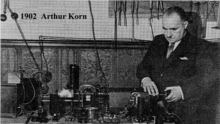Arthur Korn
| Arthur Korn | |
|---|---|
 | |
| Born |
May 20, 1870 Breslau, Germany |
| Died |
December 22, 1945 (aged 75) Jersey City, New Jersey |
| Nationality | German |
| Occupation | Inventor |
Arthur Korn (May 20, 1870, Breslau, Germany – December 21/December 22, 1945, Jersey City, New Jersey) was a German physicist, mathematician and inventor. He was involved in the development of the fax machine, specifically the transmission of photographs or telephotography, known as the Bildetelegraph, related to early attempts at developing a practical mechanical television system.[1]
Life
Korn was the son of Jewish Moritz and Malwine Schottlaender. He attended gymnasia in Breslau and Berlin.[2] He then studied physics and mathematics in Leipzig at the age of 15, from where he graduated in 1890. Afterwards he studied in Berlin, Paris, London and Würzburg. In 1895 he became a lecturer in law at the University of Munich, and was appointed professor in 1903. In 1914 he accepted the chair of physics at the Berlin Institute of Technology.
Dr. Korn, being of Jewish descent, was dismissed from his post in 1935 with the rise of the Nazi Party. In 1939 he left Germany with his family and moved to the United States, entering via Mexico. There, he took the chair in physics and mathematics at Stevens Institute of Technology in Hoboken, New Jersey. He died in Jersey City, New Jersey in 1945.
Telecommunication pioneer
Korn experimented and wrote on long-distance photography, the phototelautograph.[2] He pioneered the use of light sensitive selenium cells which took over from the function of the stylus,[3] and used a Nernst lamp as a light source. On the 17th October, 1906, he managed to transmit a photograph of Crown Prince William over a distance of 1800 km.[3][4]
At a 1913 conference in Vienna, Korn demonstrated the first successful visual telegraphic transmission of a cinematic recording. Under heavy media attention in 1923, he successfully transmitted an image of Pope Pius XI across the Atlantic Ocean, from Rome to Bar Harbor, Maine, the picture being hailed as a "miracle of modern science". From 1928 onwards, the German police used Korn's system to send photographs and fingerprints,[3] though the use of the "phototelegraph" in apprehending a thief from a Stuttgart bank in London was recorded in 1907, as well as the use of the technology by the media, with the French paper l'Illustration contracting for a French monopoly that lasted until 1909.[5]
He also worked on potential theory and the mathematics of physics.[2]
Works

- Eine Theorie der Gravitation und der elektrischen Erscheinungen auf Grundlage der Hydrodynamik (2nd ed., 1896)
- Ueber Molecular-Funktion (1897)
- Lehrbuch der Potentialtheorie (Berlin, 1899–1901)
- Freie und erzwungene Schwingungen (1910)
- Handbuch der Phototelegraphie (1911)
- Bildrundfunk with Eugen Nesper (1926)
He also contributed numerous articles to such journals as Berichte der Bayrischen Akademie der Wissenschaft, Comptes rendus de l'Académie des Sciences, and Naturwissenschaftliches Wochenschrift.
See also
References
- ↑ "Sending Photographs by Telegraph", The New York Times, Sunday Magazine, September 20, 190 7, p. 7.
- 1 2 3
 Rines, George Edwin, ed. (1920). "Korn, Arthur". Encyclopedia Americana.
Rines, George Edwin, ed. (1920). "Korn, Arthur". Encyclopedia Americana. - 1 2 3 "17.10.1906: First Photoelectric Fax Transmission ", Deutsche Welle, Accessed 20.11.09
- ↑ Solbert, Oscar N.; Newhall, Beaumont; Card, James G., eds. (September 1953). "Photos by Wire" (PDF). Image, Journal of Photography of George Eastman House. Rochester, N.Y.: International Museum of Photography at George Eastman House Inc. 2 (6): 35. Archived from the original (PDF) on 14 July 2014. Retrieved 26 June 2014.
- ↑ "Sending Photographs by Telegraph", The New York Times, New York, 24 February 1907, retrieved 1 June 2010
External links
| Wikisource has original works written by or about: Arthur Korn |